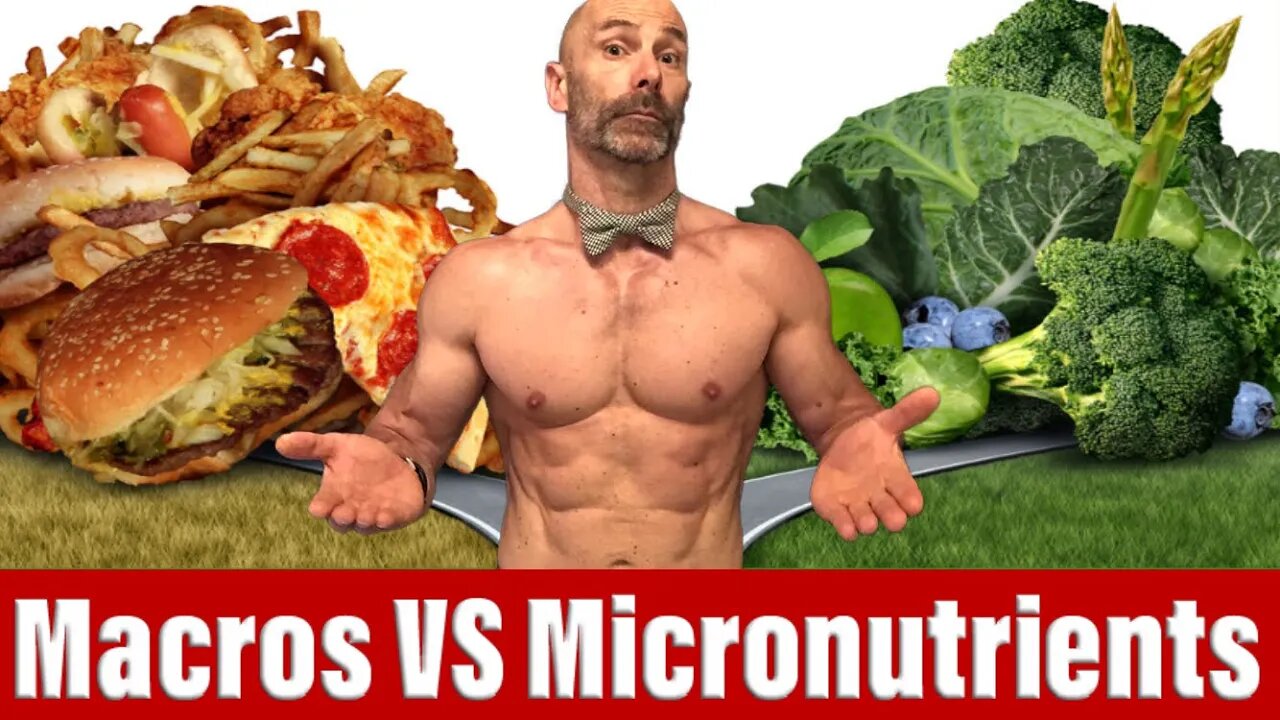Premium Only Content

Macros vs Micros What You Need To Know
Macros vs Micros what you need to know
When it comes to diet it is pretty easy to over complicate it. On the other hand, it is pretty easy to oversimplify it, too.
If your hungry, eat, if your not, don’t. That’s pretty simple.
Now if we want to optimize our diet for health and performance then we need to look a little closer at what we are eating and what that food is providing our bodies. Focusing on macronutrients which is the protein, fats and carbs found on our food vs micronutrients which are the vitamins and minerals.
The main question being, if we know what combination of macronutrients works best for us. Do we even need to pay any attention to the micronutrients? With over 30 different vitamins and minerals involved this could easily get overly complicated.
If you are interested in losing body fat and adding muscle, please email me at 1shark1bite@gmail.com for information on my personal training services.
Check your testosterone levels from home. Just click this link http://trylgc.com/laurence and receive 20% off with code: LAURENCE20 I receive commissions on referrals to LetsGetChecked. I only recommend services I know and trust.
Facebook; https://www.facebook.com/Fit-and-50-5...
My Amazon page link; https://www.amazon.com/shop/fitand50
My Affiliate link to Lebert for their Equalizer bars and more; https://lebertfitness.com/?ref=hmkesu... and use the discount code FITAND50 you will receive 15% off your purchase
Before we go too much farther we need to take a step back and look at the total calories you require to fuel your body. There are a lot of calories calculators online you can use to get an idea of how many calories you may need per day to maintain your body, but all of these are just estimates. They can give you a good place to start.
Another good way for you to find your maintenance calories is to simply track your calories and body weight for a couple of weeks. Then add up the calories you consumed for those weeks and divided that total by the number of days you tracked. That will give you your average daily calories. Then look at your weight over those weeks. Did it stay the same? If it did then you have your maintenance calories, if your weight went up then cut back by one or two hundred calories per day and do the opposite if you lost weight.
Once you have this established, then you want to start to figure out your macronutrients. We need protein to repair and rebuild our bodies including our muscle tissue after a hard workout. Fats do more than just provide our bodies with energy they also support cell growth and play an important role in hormone function. Carbohydrates are the body's primary energy source and when you eat the right types of carbs like fibre it can aid in digestion, helping you feel full and keeping your blood cholesterol levels under control.
The Dietary Guidelines for Americans have a very broad range regarding macronutrients with recommendations of 10 to 35% of your calories from protein. If you are hard training very active man then I would stay on the upper end of this recommendation. Next, they used to suggest 20 to 35% of your calories from fats. In the new guidelines, they don’t have an upper limit for fats, but for balanced dieting purposes this is a good range and it leaves 30 to 65% of your diet to be carbs.
There is a fair bit of room for personal preference here and from working with different clients I have learned that some people feel more satiated with higher fat diet and others with more carbs.
One of the biggest advantages of tracking your macros is that you're getting a balance of these main nutrients without going overboard on one or the other.
The biggest flaw is that it doesn’t account for the quality of food you eat.
If most of your food choices aren’t from a wide variety of quality minimally processed foods then odds are your not getting enough micronutrients. These micronutrients help to strengthen our bones and immune system. Heal our wounds and repair cellular damage.
But what does eating from a wide variety of whole or minimally processed foods mean? For most of us, it means eating more fruits and vegetables with vitamins like A, K, and C being very plentiful and this includes minerals like potassium.
Another great source of vitamins is nuts and seeds, like almonds, Brazil nuts and sunflower seeds. These contain good amounts of vitamin E and Magnesium.
The reason I mention those specifically is that those vitamins and minerals are the ones we most commonly don’t consume enough of.
Just start with one thing. It might be improving the quality of food you eat or take some time to figure out your overall calorie needs. Then once you are comfortable with that, add in one more thing, it might be to track just one macro like protein. I would suggest if you have one that you know you tend to either over consume or way under consume then start with that one.
-
 6:16
6:16
Fit and 50
1 year ago $0.06 earnedMike Mentzer’s High-Intensity Training (Brilliance or Madness?)
1.35K5 -
 LIVE
LIVE
FRENCHY4185
3 hours agoPRESTIGE AND CAMO GRIND : BLACK OPS 6
674 watching -
 1:29:47
1:29:47
Real Coffee With Scott Adams
3 hours agoEpisode 2669 CWSA 11/24/24
15.6K16 -
 13:52
13:52
Hershberger's Kitchen
15 hours agoTwo Delicious Dip and Spread Recipes to Try, Inspirational Thought
8.39K1 -
 3:41:05
3:41:05
Sacred Sage
6 hours ago $0.37 earnedDaz3D: Attempting to Finish Zoe Conversation!
5.71K -
![[Stream #19 ] Gaming, Chatting, you know the drill!](https://1a-1791.com/video/s8/1/9/o/E/e/9oEeu.0kob-small-Stream-Sour-Pickle-100-Foll.jpg) LIVE
LIVE
OneRandomDolly
4 hours ago[Stream #19 ] Gaming, Chatting, you know the drill!
515 watching -
 11:07
11:07
TimcastIRL
1 day agoElon Musk Suggests He’ll BUY MSNBC, Joe Rogan Will REPLACE Rachel Maddow
49.6K48 -
 34:24
34:24
The Rubin Report
21 hours agoFormer CEO: The Aftermath of Vice Media & What's Next for Mainstream Media | Shane Smith
67.3K28 -
 9:14:23
9:14:23
tacetmort3m
1 day ago🔴 LIVE - BECOMING THE UNTOUCHABLE (RADIATION WHO?) - STALKER 2 - PART 3
23.2K4 -
 16:05
16:05
China Uncensored
17 hours agoAnother Car-Ramming Strikes Outside a Chinese School!
16.6K12